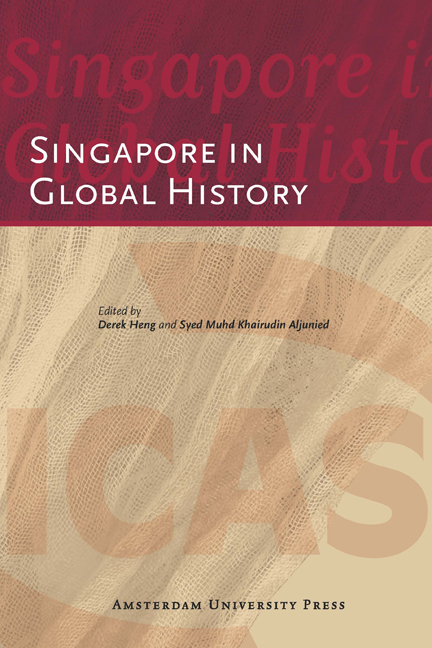Book contents
- Frontmatter
- Contents
- List of Tables and Illustrations
- Foreword
- 1 Globalising the History of Singapore
- 2 Situating Temasik within the Larger Regional Context: Maritime Asia and Malay State Formation in the Pre-Modern Era
- 3 The Singapore River/Port in a Global Context
- 4 ‘Walls of Illusion’: Information Generation in Colonial Singapore and the Reporting of the Mahdi-Rebellion in Sudan, 1887-1890
- 5 The Littoral and the Literary: Making Moral Communities in the Straits Settlements and the Gold Coast in the late Nineteenth and Early Twentieth Century
- 6 Social Discourse and Economic Functions: The Singapore Chinese in Japan’s Southward Expansion between 1914 and 1941
- 7 The Dynamics of Trans-Regional Business and National Politics: The Impact of Events in China on Fujian-Singapore Tea Trading Networks, 1920-1960
- 8 Rambutans in the Picture: Han Wai Toon and the Articulation of Space by the Overseas Chinese in Singapore
- 9 The Global Effects of an Ethnic Riot: Singapore, 1950-1954
- 10 The British Military Withdrawal from Singapore and the Anatomy of a Catalyst
- 11 Bringing the International and Transnational back in: Singapore, Decolonisation, and the Cold War
- 12 The Global and the Regional in Lee Kuan Yew’s Strategic Thought: The Early Cold War Years
- 13 A Brief History of the Hub: Navigating between ‘Global’ and ‘Asian’ in Singapore’s Knowledge Economy Discourse
- About the Contributors
- Bibliography
- Miscellaneous Endmatter
4 - ‘Walls of Illusion’: Information Generation in Colonial Singapore and the Reporting of the Mahdi-Rebellion in Sudan, 1887-1890
Published online by Cambridge University Press: 02 February 2021
- Frontmatter
- Contents
- List of Tables and Illustrations
- Foreword
- 1 Globalising the History of Singapore
- 2 Situating Temasik within the Larger Regional Context: Maritime Asia and Malay State Formation in the Pre-Modern Era
- 3 The Singapore River/Port in a Global Context
- 4 ‘Walls of Illusion’: Information Generation in Colonial Singapore and the Reporting of the Mahdi-Rebellion in Sudan, 1887-1890
- 5 The Littoral and the Literary: Making Moral Communities in the Straits Settlements and the Gold Coast in the late Nineteenth and Early Twentieth Century
- 6 Social Discourse and Economic Functions: The Singapore Chinese in Japan’s Southward Expansion between 1914 and 1941
- 7 The Dynamics of Trans-Regional Business and National Politics: The Impact of Events in China on Fujian-Singapore Tea Trading Networks, 1920-1960
- 8 Rambutans in the Picture: Han Wai Toon and the Articulation of Space by the Overseas Chinese in Singapore
- 9 The Global Effects of an Ethnic Riot: Singapore, 1950-1954
- 10 The British Military Withdrawal from Singapore and the Anatomy of a Catalyst
- 11 Bringing the International and Transnational back in: Singapore, Decolonisation, and the Cold War
- 12 The Global and the Regional in Lee Kuan Yew’s Strategic Thought: The Early Cold War Years
- 13 A Brief History of the Hub: Navigating between ‘Global’ and ‘Asian’ in Singapore’s Knowledge Economy Discourse
- About the Contributors
- Bibliography
- Miscellaneous Endmatter
Summary
“News of what is going on in one corner of the world is quickly known in another corner.” (Singai Nesan [Cinkai Nēcan], 13 May 1889: 180).
Introduction
News spreading in an instant from one corner of the world to another – this quote conjures up terms all too well-known in the world of the twentyfirst century: new media, knowledge-based economies, information technologies. But it relates to a time which few of us would think of in this manner: written in early 1889 by a Muslim newspaper-editor in Colombo (Muslim Nesan [Muslim Nēcan], 24 Cittirai 1889: 29) and reprinted somewhat later in a Tamil weekly newspaper in Singapore, with reference to events unfolding in the steppes and deserts of the Sudan. Surrounded as we are by the trappings of a technology which allows news to be transmitted almost instantaneously, it may be difficult for us to see the late-nineteenth century as experiencing its own ‘information revolution’. And yet, at least as far as Singapore was concerned, in a sense this was the case.
There were two developments which helped transform Singapore's ‘information order’ in the late-nineteenth century (Bayly 1996: 3-6). The new technology of the telegraph, which linked Singapore to Europe since 1870, revolutionised the transmission of information. At the same time, a fundamental development took place in Singapore's newspaper market: the appearance of the first newspapers not printed in English, but in Asian “vernaculars”, as they were known in the language of the time (cf. Birch 1879). These newspapers all formed part of what Timothy Harper has called a “diasporic public sphere” in colonial Singapore, “a polyglot migrant world… in which communities not only had to find ways to relate to distant homelands, but had to learn to speak to each other, in many cases for the first time” (Harper 1997: 263).
Yet what role Singaporean newspapers played in this public sphere in the late-nineteenth century remains an open question. While important work has been done on the role of Singapore newspapers in the public sphere in the twentieth century (e.g. Chua 2008b), the early history of these developments still needs to be traced.
- Type
- Chapter
- Information
- Singapore in Global History , pp. 67 - 88Publisher: Amsterdam University PressPrint publication year: 2012



